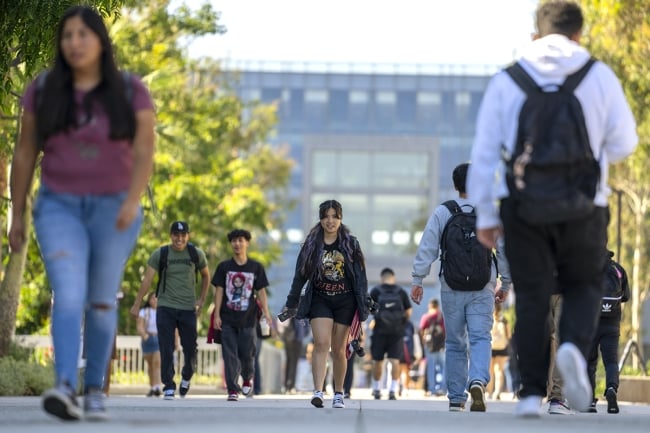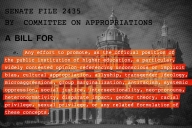You have /5 articles left.
Sign up for a free account or log in.

Early Common App data show a surge in applications this fall, eclipsing even pre-pandemic numbers.
iStock Editorial/Getty Images
Early numbers suggest this fall’s application cycle could bring admissions offices a much-needed infusion of optimism after a fraught and transformative year.
Preliminary data from the Common App—which counts about one-third of America’s four-year undergraduate institutions as members—show a sharp increase in applications submitted before Nov. 1, a jump of 41 percent over the 2019–20 application cycle.
Applications from minority students increased 67 percent, an especially significant upswing for the first application cycle after the Supreme Court struck down race-conscious admissions in June. Applications from students at high schools in lower-income ZIP codes also rose more than the general rate: 52 percent since 2019–20, versus 32 percent from wealthier ZIP codes.
The number of individual students using the Common App increased 12 percent year over year, and those from underrepresented racial and ethnic groups rose by 21 percent.
Mark Freeman, the Common App’s vice president of data analytics and research, said the data mostly represent early or rolling applications. Even so, he said the growth is both “large in absolute terms and large given our history.” He credits a surge in the platform’s institutional members for most of the boost.
“We’ve been adding a lot more members to the platform, from more large public flagships to a lot of HBCUs and other [minority-serving institutions],” he said.
Robert Massa, vice president emeritus for enrollment at Dickinson College, said he was struck by the size of the application surge. But he cautioned that it may reflect the growing popularity of early action and early decision—and increased pressure on students to apply to a longer list of colleges—rather than portend a comparable spike in enrollments next year.
“We probably won’t see the same numbers at the end of the cycle,” he said.
Applications increased more at public institutions than private: 82 percent versus 47 percent since 2019. Freeman chalked this up largely to the increase in the Common App’s public members, including 28 large state flagships added in the past decade; this summer the platform added Rutgers University, a longtime holdout.
Massa cited another reason for the gap between public and private application growth.
“Price matters,” he said, “and as students are increasingly skeptical of higher ed or opting not to go, more are focusing on cheaper public options first.”
Freeman declined to share data on how many colleges have opted to include the demographic data of applicants on information sheets meant for admissions offices, a practice that has been discouraged by legal activists in the wake of the Supreme Court decision and which some institutions, including Yale University, have promised to opt out of.
But he said some of the major differences he expected to see after the Supreme Court decision against affirmative action—like higher rates of self-reported demographics—never materialized.
“We went into this cycle having set up a number of new metrics to track race and ethnicity reporting, changes in where certain students were applying,” he said. “We were fully prepared for that to be a much bigger deal. But it wasn’t.”
More Applications, Even Earlier
The number of students choosing to apply via early admission has leaped in recent years, and the number of institutions offering an early-action option has also increased substantially. That could account for some of the growth in applications submitted by Nov. 1.
Freeman said that early action is “far and away the fastest-growing application option” on the Common App; the number of early-action and early-decision applications combined is nearly equal to those submitted for regular decision. Applications for the first round of EA and ED increased by 38 percent since 2019, and second-round applications grew by 90 percent, according to unpublished data provided by the Common App.
“Internally, we talk about early action as the new regular decision,” he said.
Massa said he’s seen an explosion of interest in early applications, primarily for highly selective institutions but increasingly across the access spectrum. He spoke with counselors and students at a private high school in New Jersey on Tuesday and said that the 55-person senior class had submitted over 300 early applications.
Freeman said the boom in test-optional policies during the pandemic helped spur the increase in applications. Before 2020, about half of institutions still required standardized test scores; the vast majority of those switched temporarily to test optional during the pandemic, and most have extended those policies or made them permanent.
“As the barriers to entry keep falling, it’s only a natural outcome that more students are applying to more institutions,” Freeman said.
In 2020–21 that growth largely affected selective institutions that were test optional for the first time, drawing more interested applicants from a wider pool. This fall, growth at the highly selective echelon has leveled off, and the most significant increases have been at institutions with acceptance rates of 50 percent or higher.
The Common App data also show transformative changes in international applicants, largely in line with the Open Doors report on 2022–23 international student enrollment released earlier this week. Applications from China decreased by 18 percent since 2019, while applications from India rose 118 percent and those from Ghana and Nigeria rose 1,066 percent and 347 percent, respectively.
Focus on Diversity Post-SFFA
Many more applications came from nonwhite students this year than in 2019, with some groups seeing an especially large spike: applications from Black students went up 70 percent, for instance, and those from Native Americans rose 86 percent.
Freeman said the steep rise in minority applications is partially due to the 77 percent increase in minority-serving institutions using the Common App since 2019. Much of that growth has occurred since the organization launched an outreach initiative for MSIs in 2021.
He also said that aside from the platform’s own equity-driven mission, member institutions are seeking more help in targeting and attracting racially diverse applicants in the wake of the Supreme Court decision.
Massa posited that the affirmative action ban played a role in nonwhite students’ decisions about which, and how many, colleges to apply to.
“There may be this notion that because affirmative action is dead, I need to apply to more colleges to increase my chances,” he said.
But ultimately, the rise in nonwhite applicants is part and parcel of the general long-term demographic shifts in higher ed. The number of white applicants has decreased by 10 percent in the past decade, Freeman said, and the growth rate for nonwhite applicants has been about double the general trend lines for a number of years now.
“Even if we weren’t intentionally recruiting MSIs and trying to increase access, we’d probably see the same general pattern,” he said.









